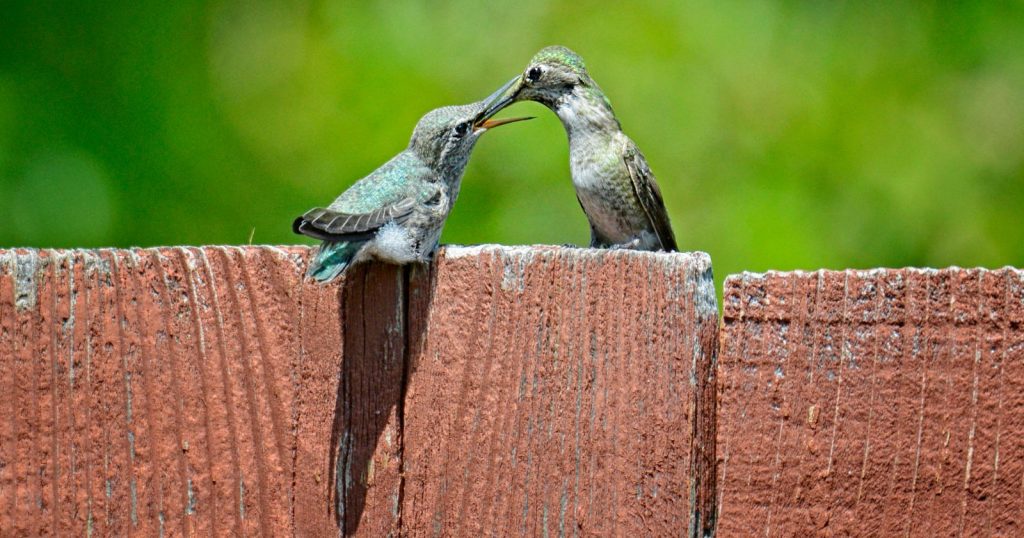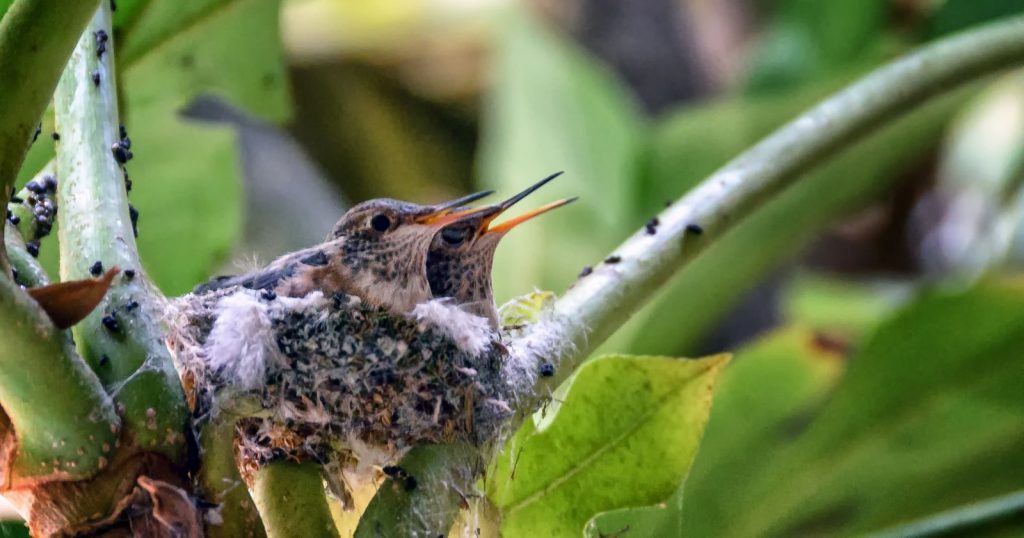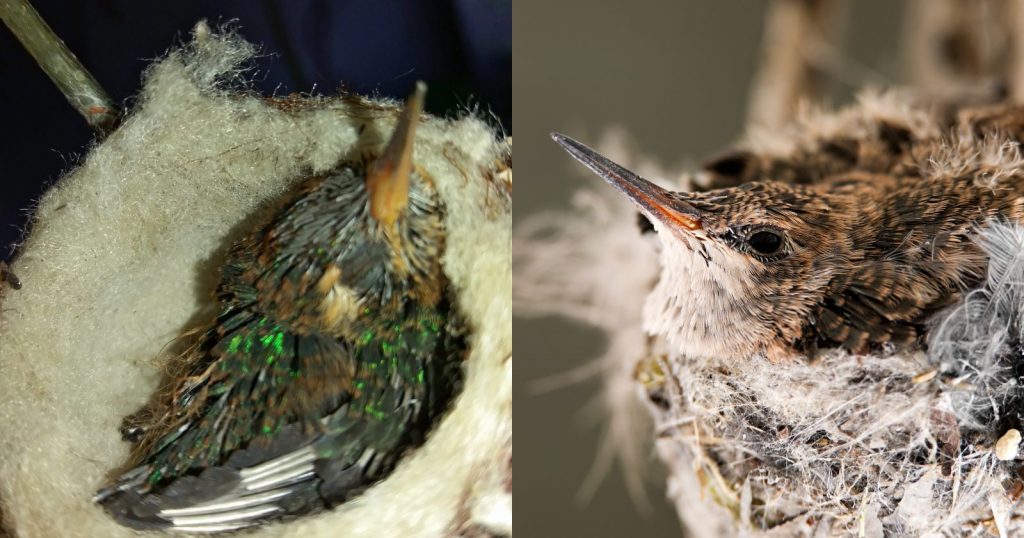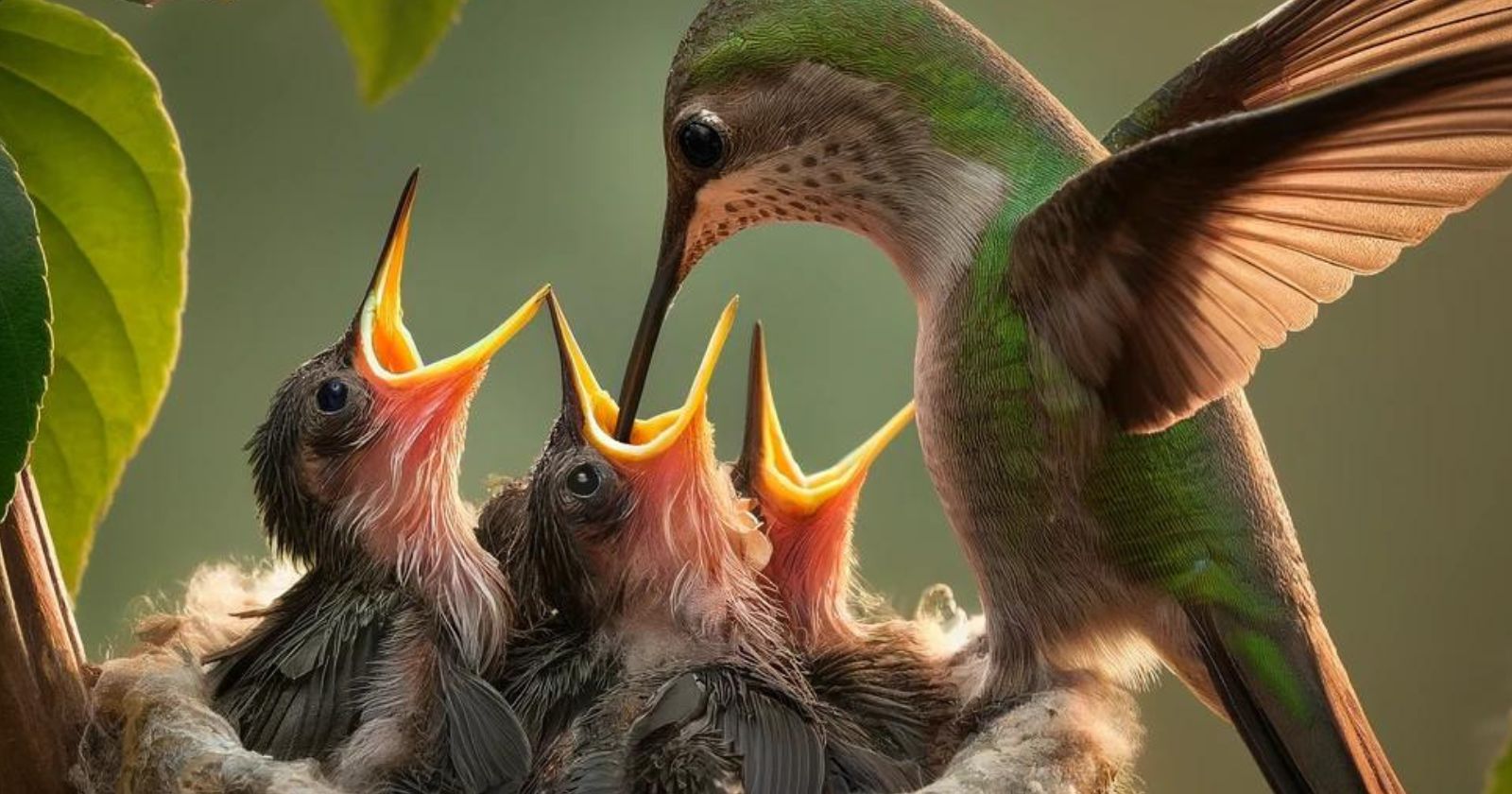Baby hummingbirds have a unique diet that changes as they grow. From the moment they hatch, these tiny birds rely on their mother for nourishment, consuming a carefully balanced mixture of nectar and small insects. This specialised diet provides the essential nutrients and energy needed for their rapid growth and development.
In this blog post, we will explore the world of baby hummingbird nutrition. We’ll look at their dietary needs at different stages of growth, the crucial role their mother plays in feeding them, and how their diet evolves as they prepare for independence.
We’ll also discuss ways you can support hummingbird families in your garden and what to do if you find an orphaned baby hummingbird.
Key Takeaways: What Do Baby Hummingbirds Eat?
Baby hummingbirds eat a mixture of nectar and small insects regurgitated by their mother. Their diet changes as they grow, with younger chicks needing more nectar for energy and older nestlings requiring more protein-rich insects for proper development.
What is the main food source for hummingbird chicks?
The main food source for hummingbird chicks is a combination of nectar and small insects provided by their mother. This mixture is regurgitated directly into the chicks’ mouths, ensuring they receive the perfect balance of quick energy from nectar and essential proteins from insects.
Related Post: 9 Surprising Facts About Hummingbird Nesting You Need to Know.

The Evolving Diet of Baby Hummingbirds
Newborn to Young Nestlings (First 1-2 Weeks)
When baby hummingbirds first hatch, they’re incredibly tiny and vulnerable. At this stage, their diet consists primarily of:
- A mixture of nectar and small insects
- Regurgitated by the mother directly into their mouths
- Nectar provides quick energy
- Insects supply essential protein for growth.
The mother hummingbird carefully balances the ratio of nectar to insects, ensuring her chicks receive the perfect blend of nutrients. This mixture is easy for the young birds to digest and provides the energy they need for their rapid development.
Older Nestlings (2-3 Weeks Old)
As the baby hummingbirds grow, their dietary needs change slightly:
- The proportion of insects in their diet increases
- More protein is required for proper growth and development
- Common insects fed include:
- Mosquitoes
- Gnats
- Fruit flies
- Small spiders
- Aphids.
At this stage, the mother continues to regurgitate food for her chicks, but the composition shifts to include more protein-rich insects. This change in diet supports the development of strong muscles, bones, and feathers.
Fledglings (3-4 Weeks Old)
As baby hummingbirds approach fledging age, their diet undergoes another transition:
- They begin learning to feed themselves
- Still supplemented by the mother
- Start drinking nectar from flowers and feeders
- Begin catching small insects on their own.
This period is crucial for young hummingbirds as they develop the skills needed to survive independently. The mother continues to provide food while encouraging her offspring to explore and learn.
The Mother’s Role in Feeding
The mother hummingbird plays a vital role in the feeding process of her young:
- Feeds chicks every 20-30 minutes from dawn to dusk
- Leaves the nest up to 200 times a day to gather food
- Regurgitates partially digested food directly into chicks’ mouths
- Continues feeding for about a week after fledging.
This demanding schedule highlights the incredible dedication of hummingbird mothers. Their tireless efforts ensure their chicks receive the nourishment needed for healthy growth and development.
Importance of Protein in Baby Hummingbirds’ Diet
While nectar is often associated with hummingbirds, protein from insects is crucial for baby hummingbirds:
- Essential for rapid growth and development
- Helps build strong bones and muscles
- Supports feather growth
- Aids in the development of the nervous system
Without adequate protein, baby hummingbirds would struggle to develop properly and may not survive to adulthood.

Challenges in Feeding Baby Hummingbirds
Feeding baby hummingbirds is a delicate and demanding task:
- Requires frequent feedings throughout the day
- The diet must be precisely balanced
- Chicks can easily choke if not fed properly
- Risk of overfeeding can lead to serious health issues.
These challenges underscore why it’s crucial for baby hummingbirds to be cared for by their mothers or, in rare cases, by experienced wildlife rehabilitators.
Supporting Hummingbird Families in Your Garden
If you want to help hummingbird mothers feed their young, consider:
- Planting native flowers that attract insects
- Avoiding pesticides in your garden
- Providing a shallow water source for insects
- Hanging hummingbird feeders with proper nectar solutions.
By creating a hummingbird-friendly environment, you can indirectly support the nutrition of baby hummingbirds in your area.
What to Do If You Find an Orphaned Baby Hummingbird
If you come across a baby hummingbird that appears to be orphaned or injured, it’s important to know how to respond:
- Observe from a distance: Sometimes, the mother may be nearby but out of sight.
- Check for injuries: Look for any visible signs of harm or distress.
- Contact a wildlife rehabilitator: These professionals have the expertise to care for baby hummingbirds properly.
- Keep the bird warm: If you must move it, place it in a small box lined with soft cloth.
- Don’t attempt to feed it: Improper feeding can be dangerous for the bird.
Remember, it’s always best to leave wildlife care to the experts. Well-meaning attempts to help can often do more harm than good.
Comparison: Baby Hummingbird Diet vs Adult Hummingbird Diet
To better understand how a hummingbird’s diet changes as it grows, let’s compare the diet of baby hummingbirds to that of adults:
| Aspect | Baby Hummingbirds | Adult Hummingbirds |
|---|---|---|
| Primary Food Source | Regurgitated mixture from mother | Self-obtained nectar and insects |
| Nectar Consumption | Part of regurgitated mixture | 90% of diet |
| Insect Consumption | Increasing proportion as they grow | 10% of diet |
| Feeding Frequency | Every 20-30 minutes | Every 10-15 minutes |
| Feeding Method | Fed by mother | Self-feeding |
| Dietary Balance | Changes as they grow | Relatively constant |
This comparison highlights the significant changes in diet and feeding habits as hummingbirds mature from helpless chicks to independent adults.

Final Thoughts
The journey of a baby hummingbird from a tiny, helpless chick to a self-sufficient adult is truly remarkable. Their specialized diet, provided by their loving and dedicated mothers, plays a crucial role in their rapid growth and development.
Understanding what baby hummingbirds eat not only deepens our appreciation for these fascinating birds but also helps us create environments that support their survival.
So, before I leave, I have a question for you: Have you ever observed the feeding habits of baby hummingbirds? Share your thoughts in the comments below!
If you found this post helpful, please share it with others who might enjoy learning about these incredible birds. Thank you for reading!
